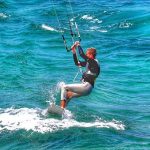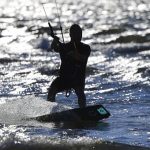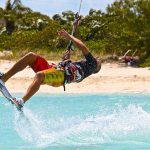Anyone can go out and buy a kite, learn how to fly it, and then start teaching kitesurfing. It is not the same to take a lesson with any kitesurf instructor than with a qualified one.
Lessons with a qualified kitesurf instructor
” Qualified” means that your instructor has received professional training from a reputable organization and has received a qualification that highlights the instructor’s skills as a kiteboarder and ability to teach the sport safely and effectively.
It is important to take accredited driving lessons from a qualified instructor because they will teach you using a methodology that respects safety and quality standards.
The same way that some schools commit to quality standards, IKO Centers guarantees proper practices of kitesurfing.
Learning at an affiliated school will give kiters the peace of mind that they’re being taught correctly.
An affiliated school, like all IKO Centers, will be able to help you with everything you need, both on and off the water.
Affiliated schools have facilities that are fully functioning and will help make sure you are ready and safe to get into the water. While you are on the water, affiliated schools are equipped and trained to deal with water rescue situations if there is an emergency.
Kiteboarding may seem like a dangerous sport, but it can be safe if it is learned properly. Taking kitesurfing lessons from a trained instructor will help you learn the sport safely and progress quickly.
How long does it take to learn to kitesurf?
Everyone learns at their own pace, so there is no set time frame for learning to kitesurf. Some people may pick it up quickly, while others may take longer. It all depends on your individual skills, expectations, and goals.
This means that if you took, for example, four lessons of three hours each, it would take you at least 12 hours to complete the first three steps.
It takes a long time because there is a lot to learn. A good instructor will not only show you how to kite but will teach you how to become independent in all facets of the sport.
Is it possible to learn kitesurfing in one day? While some experienced watermen may be able to do so, it does not mean that they know how to safely and effectively kitesurf overall. This can lead to increased risk of injuries or accidents.
We suggest that if you plan to learn to kite on a trip or during your vacation, you give yourself at least a week. Having a week also gives you some leeway in case the wind isn’t good every day, or if you want to take some days off.
However, if you are able to take more than a week, it is even better. During the first week you learn how to ride, and the second week you can practice and enjoy as much as you want.
How much does it cost to learn to kitesurf?
This is true in literally everything we do in life but especially apparent in the world of kiteboarding. Everything comes with a cost, including kiteboarding.
However, people often forget that the cost of something is not always proportional to its value. This is true for everything in life, but it is especially apparent in the world of kiteboarding.
The costs of kitesurfing will vary depending on certain variables, such as where you learn and which brand of equipment you buy. Other costs may include commuting to a kiteboarding location and other factors.
Kitesurfing lessons cost different amounts depending on the location and school.
For example, in Dubai, which has a high cost of living, you might pay $100 per hour, while in other cheaper locations you might pay $40-$50 per hour. Most people spend $500-$800 on lessons to get a complete course and be able to kitesurf independently.
The cost of kitesurfing equipment will vary depending on the country you buy it in and the brand. Import taxes and other factors also vary by destination, so we’ll just look at the basics.
In general, you can expect to spend around $3,000 on a new kite, bar, harness, life jacket, helmet, and board.
The lifespan of this investment varies depending on how it’s taken care of and how often it’s used, with the average being 3,000 USD. Some people spend less on a quiver, while others spend more money to have a larger quiver.
The cost of kitesurfing equipment can vary greatly, from those who want top-of-the-line gear spending up to $10,000, to those who are happy with second-hand gear spending as little as $1,000. It all depends on the individual’s needs and wants.
6 Kitesurfing myths debunked
Myth #1 It’s only for the fit
It is helpful to be physically fit to excel at kitesurfing, as it is with most other sports; however, kitesurfing does not require a great deal of physical strength. The harness takes most of the pressure, allowing the kite to be balanced with the body instead of the arms.
As a result, individuals of most fitness levels can kitesurf. Without realizing it, kitesurfing will also help to improve one’s fitness.
Myth #2 Yeah but I’m too: old / young / fat / skinny / *
Your age should not stop you from trying something new. If you have back problems, there are harnesses that can help you. Kiteboarding does not require as much physical effort as you might think.
Although weight may seem like it matters, it doesn’t have as much of an effect as you might think. I’ve seen riders who weigh over 120kgs doing tricks, jumps, and carving waves effortlessly. Even lightweight kiters can ride when others can’t.
There are different kite and board sizes to suit most kitesurfers, no matter their weight and height.
There are many great things about kiting, one of which is that you will never be judged. Kitesurfing is a great way to meet new people who will support you on your kiting journey. It does not matter if you are overweight because many people are.
Do not let that stop you from getting out there and being active. Kitesurfing will change your life for the better in many ways, including your approach to life, diet, and self-discipline.
Myth #3 Kitesurfing is dangerous
Kitesurfing has progressed a lot in the last ten years. The kites are much safer and easier to control, they can release excess power when a gust of wind comes, and you can easily get rid of the kite if you feel that something is about to go wrong.
As with everything else in life, it all comes down to common sense, safe equipment, and proper training.
You will be safe if you take lessons. You will need to master kite control, board control, and safety on both water and land. You will learn the rules of the water and other things during our course.
The majority of accidents occur when individuals attempt to teach themselves kitesurfing on inadequate gear. Kites have sufficient force to lift us approximately 25 meters into the air; as of now, the world record is held by Nick Jacobsen for jumping 28.6m in Cape Town.
Myth #4 Kitesurfing is hard to learn
The difficulty of kitesurfing varies from person to person, with about 75% of the skill being flying the kite and the rest being board work. In most cases, students can safely practice on their own after a two-day IKO course.
We prioritize safety in kiteboarding, so you will only be allowed to practice on your own once we are confident in your abilities.
It’s easier to learn kitesurfing than windsurfing or surfing, in my opinion. With the right teacher, you’ll be able to do it quickly.
Like everything else, it just takes some effort and practice. And Scotland is a great place to kitesurf, with lots of great beaches from Edinburgh to the Highlands, West Coast, and Hebrides.
Myth #5 Trainer kite is a great idea
When you fly a kite without a harness, you are pulled along by the kite through your hands. This feels completely different than being pulled by the kite through a harness.
Flying kites on land is dangerous. I learned this lesson a long time ago. A guy tried to get on the course for over 5 months. When he finally got on the same lesson as me, he got pulled by a trainer kite in the first 15 minutes, smashed his knee on a rock, and had to go back home. That’s why you should only have lessons in the water.
You will learn all the kite skills you need to safely practice on your own with proper water kites.
Don’t buy something you’ll only use once and will eventually forget about. For a few more pounds, you can get a much better quality wetsuit that will last longer. It’s a smarter investment.
Myth #6 Gear is expensive & I can just get a cheap kit from eBay
eBay is full of affordable items, but you should be wary of buying gear from unknown sellers. It’s crucial to take care of your kiteboarding equipment, including giving it a thorough wash after every session to prevent salt damage.
Although kitesurfing requires some initial investment, it is no different than any other sport in this respect.
The main difference is that kiting only requires wind, which is free once you have your equipment. In addition, we offer greatly discounted kite package deals to all of our former students so that you can get the gear that is just right for you without breaking the bank.



